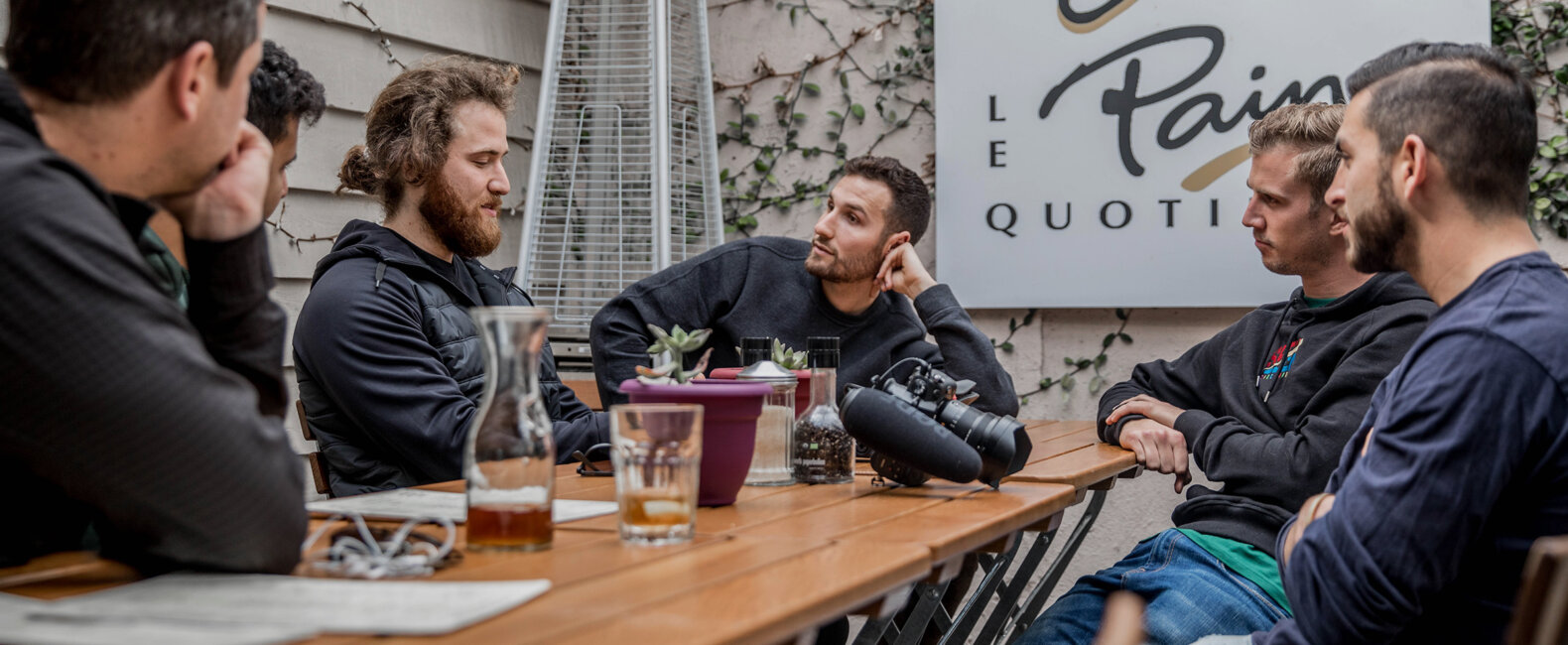We’re firm believers in the idea that the most successful creatives aren’t in it for the success. It’s quite the paradox, but it makes a little more sense when you look at the exploding YouTube channel known as Yes Theory. Their team consistently creates viral videos with substance, has built a following with more than 3.5 million subscribers, and shows no sign of slowing down. How? Well, back to that paradox:
“To be honest, I’m not an advocate for looking at subscribers,” Yes Theory Manager Zack Honarvar told us. “We realized as a team that subscribers are really just a vanity metric.”
Yes, you heard him right. One of the most successful channels out there doesn’t pay attention to subscribers. In fact, they have a holistic approach to their audience that’s much more in-depth — and much more valuable. They’ve used this philosophy to build a channel based on ‘going for it’, along with a massively bought-in audience.
We talked to Zack about the business behind YouTube, their secret metric to success, and why he chose to dive into below-freezing water with a meditative Dutch guru.
Musicbed: Are you directly involved with Yes Theory’s shoots?
Zack Honarvar: I’m involved with a large portion of the shoots, but I’m usually in the background. I tend to provide a natural contrast to the guys. They’re very much into seeking discomfort, getting out of their comfort zones, and doing crazy things. I tend to play the more rational personality in the videos, just adding the perspective of what everyone else in the world is thinking [laughs].
The Wim Hof documentary was insane.
Yeah, I came on to go through that whole experience with them and ended up doing all of the challenges. For me, it was important to put some skin in the game. I find it weird when managers don’t believe in the philosophy or the ideology of what they are commoditizing, selling, and sharing with the world.
We jumped from 20 feet into ice-cold water in Poland and stayed for 10 minutes in below-freezing water. Everyone had told us before that moment that after three minutes you’d get hypothermia and die. Then, we hiked a mountain in four-degree temperatures in nothing but our shorts. Until we showed up, we all thought this was the type of experience that would kill you. To do that alongside the team was…very interesting.
And you’re thinking, What have I done?
“They told me it would be fun, just manage these guys and it’ll be great.” [Laughs] We definitely joked about that a lot, but it was great and a huge learning opportunity for me.
As a manager, how do you even plan for Yes Theory’s spontaneity?
It’s funny because we’re probably even more spontaneous than it seems. We probably downplay it just a little bit to not make it seem utterly insane. But, how do I manage that? Great question. There’s an understanding that good content comes from spontaneity to a degree. For example, we constantly incorporate strangers into our videos and just trust the process and trust the idea that the kind of person that will say “yes” to anything will be great for a video.
Just trusting in our process is what has made it work. That, and just being quick on my feet to think of business opportunities without having to sit down and think for a week.
How do you know which branded opportunities to capitalize on?
I always look for brands that can enhance the piece of content we’re creating, a brand that can basically connect the dots to something that we wouldn’t be able to do ourselves, whether that’s through an experience they’re able to offer or something as simple as budget constraints.
The brand itself also has to be something that we would stand by and want our audience to use. We need to be able to know what we stand for and to know what we don’t stand for, that way our audience knows that we just won’t put anything in front of them.
How do you sustainably produce sponsored content?
I think people who have an audience that follows them for a purpose rather than just simple entertainment will succeed in the end. If someone’s just making content that’s funny I think they’ll be the first to lose those branded opportunities because they’re not moving anyone through a message. It’s just entertainment.
Yes Theory is a little different because people are following us because of the philosophy. It’s a way for them to live their lives. I think that we have more moving power for our audience to be able to engage and mobilize our audience to either check out a brand, buy a product, or look into a service. Especially when it’s something the team uses and stands behind.
Obviously, the creative content is what got Yes Theory to this place. How do you balance business opportunities with creative output?
It starts with understanding where the guys find fulfillment and happiness. What do they enjoy doing and where do they want to progress as individuals? I don’t manage Yes Theory. I manage all of the people in Yes Theory as human beings. If I can get them to where they want to go in their individual careers, then we’ll be successful as a result.
I let them handle the day-to-day creative and video output, through pre-production, production, and post-production. I just set up the infrastructure to let them be successful — diversifying into different streams of revenue and things like that.
What’s your advice for diversifying content?
There’s a time to diversify, but if you start too early you can start to spread yourself too thin and nothing will take off. When I started working with the guys, we had around 300,000 subscribers and they had plans to do a book, a festival, and a podcast. All these different things. We looked at it and eventually decided that 300,000 wasn’t a big enough number to convert people to different forms of content.
So, we decided to just focus on one thing. Do one thing really, really well and grow an audience in it. Leave diversifying for the future when you have a larger following.
Now that we’re at 3.5 million subscribers, this will be the year of diversifying. And it’s important. As a YouTube creator, you don’t own your audience. YouTube owns your audience. If YouTube shuts down tomorrow you can’t take any of those people with you. Or if you screw up and they stop monetizing your videos, i.e. Logan Paul, you have to have something else that you can rely on to start building back up.
Is the number of subscribers you have a good indicator of success?
To be honest, I’m not an advocate for looking at subscribers. We realized as a team that subscribers are really just a vanity metric. It used to be our north star number, but we’ve actually changed that number to the number of people who’ve taken action or been impacted. It’s not even a YouTube number, so to speak.
We started to think more and more about building videos, challenges for our audience, where we can actually track and quantify how many people are taking action to better their lives or their situation. For example, we made a video where we asked our audience to go for a mile run and then share their video — we got 27,000 pledge forms submitted and 8,000 videos submitted. Then we created a big UGC (user-generated content) piece around that.
To us, it means so much more than someone just clicking ‘subscribe’ and passively watching videos. It means they watched our video, put the phone or computer down, and actually did what our philosophy empowered them to do.
That’s become our new success metric. We track it using a hashtag counter to count how many times it’s been used or even a response page on our website where people can reflect on how an experience made them feel.
“To us, it means so much more than someone just clicking ‘subscribe’ and passively watching videos. It means they watched our video, put the phone or computer down, and actually did what our philosophy empowered them to do.”
Why does action matter more than the size of an audience?
From a philosophy standpoint, it obviously makes a difference. From a business perspective it makes a difference as well, I suppose. If an audience is more willing to take action based on your ask, they’re also probably willing to support you financially as well. Whether you’re putting merchandise in front of them or a product that the brand supports.
I mean, we can get 27,000 people to go run a mile. If in a year or two, we decided to create our own marathon, then we’re in a realm where we can begin to convert an audience.
Do enough YouTube creators think about the business side of things?
I’m not sure if entrepreneurship is a skill that can be learned, but I think it’s important to be creative in ways to find out what people’s core needs are. A lot of YouTube channels try to look at routes that have already been paved for them by previous creators. I don’t think there’s a creator in the history of the platform who has figured out what the evolution of a digital creator looks like.
That’s just because people haven’t approached it from an entrepreneurial standpoint, to look at the nuts and bolts of supply and demand, the economics of making a living through creative content — maybe without the approvals of big, traditional distribution companies.
Not to ramble too much, but I believe a lot of these digital creators on YouTube have their finger on the pulse of what millennials want to watch, more so than people who are buying TV shows on Netflix or different TV networks. Creators need to trust themselves, trust that they know more than the TV executives. Then someone — a business or manager — needs to empower those creators to trust their gut instinct and go for it.
The team at Yes Theory put together a playlist with some of their favorite songs from our roster! Listen to it below and license any of the songs for your next video:


















































































